ECON1010, Sem1 2019, University: Macroeconomics 1 Policy Brief Report
VerifiedAdded on 2023/03/20
|10
|1748
|37
Report
AI Summary
This ECON1010 Macroeconomics 1 policy brief analyzes the economic state of the United States, examining key indicators such as GDP and inflation to diagnose the economic health and identify challenges. The report focuses on the persistent issue of unemployment, presenting both short-term and long-term economic observations. Part A of the report provides a diagnostic analysis of the US economy, while Part B presents a policy brief with recommendations to address unemployment. The recommendations include the implementation of expansionary monetary policies through reduced interest rates, and fiscal policies like increased government spending or tax cuts. The rationale behind these recommendations is to stimulate economic growth, create more job opportunities, and ultimately reduce the unemployment rate. The report also includes a discussion on the impact of monetary and fiscal policies, offering a comprehensive approach to tackling unemployment within the US economy. The document concludes with a list of references supporting the analysis and recommendations.
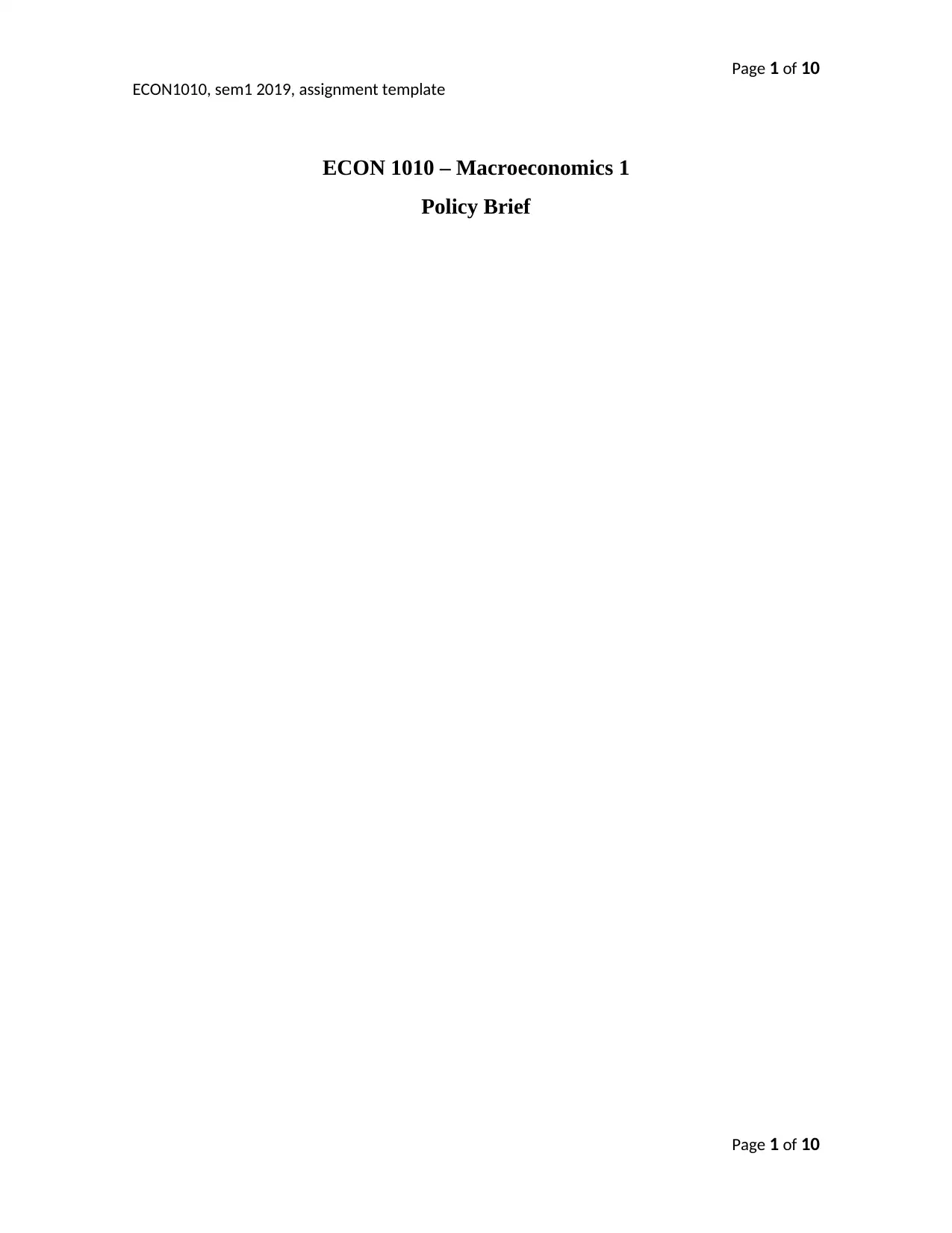
Page 1 of 10
ECON1010, sem1 2019, assignment template
ECON 1010 – Macroeconomics 1
Policy Brief
Page 1 of 10
ECON1010, sem1 2019, assignment template
ECON 1010 – Macroeconomics 1
Policy Brief
Page 1 of 10
Paraphrase This Document
Need a fresh take? Get an instant paraphrase of this document with our AI Paraphraser
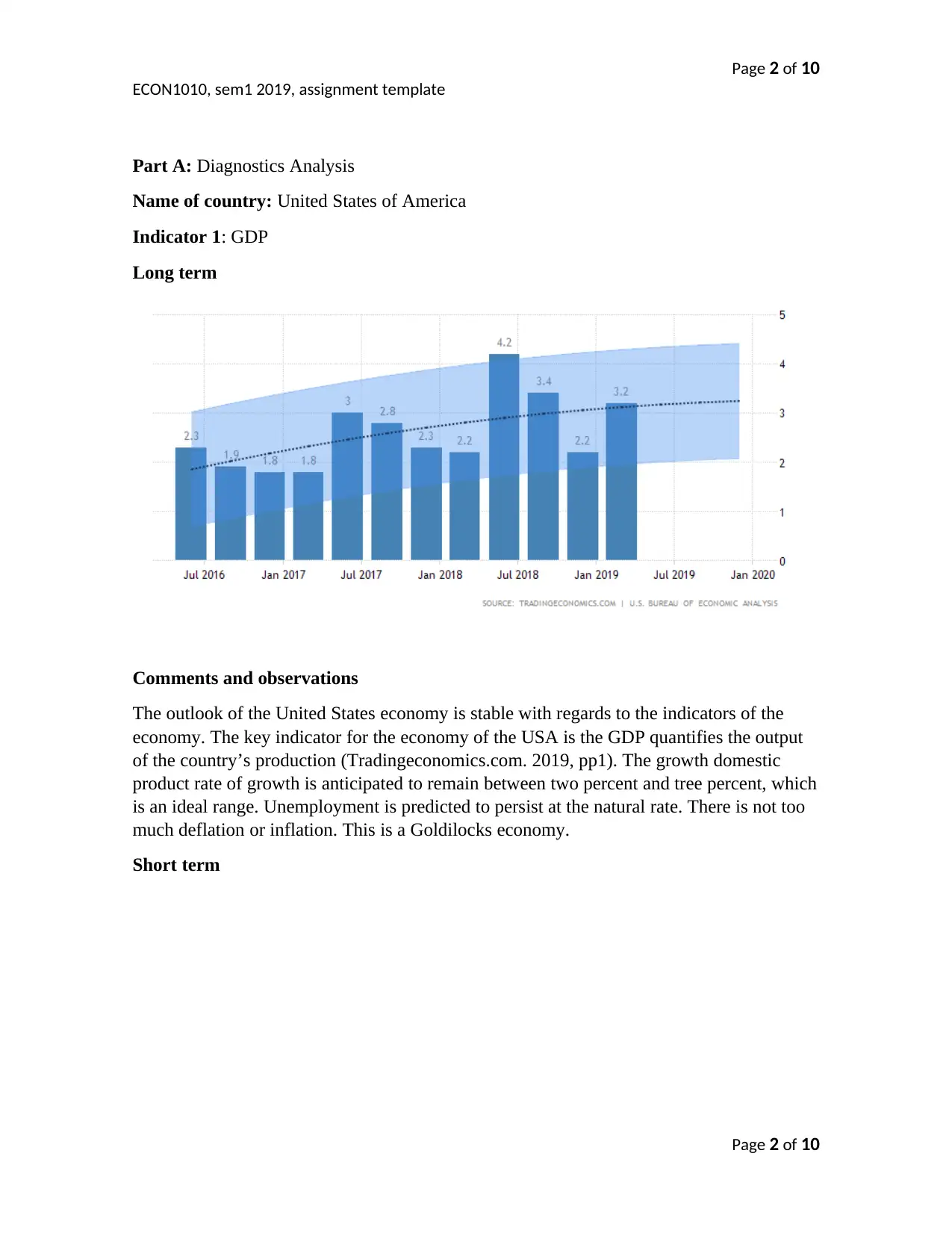
Page 2 of 10
ECON1010, sem1 2019, assignment template
Part A: Diagnostics Analysis
Name of country: United States of America
Indicator 1: GDP
Long term
Comments and observations
The outlook of the United States economy is stable with regards to the indicators of the
economy. The key indicator for the economy of the USA is the GDP quantifies the output
of the country’s production (Tradingeconomics.com. 2019, pp1). The growth domestic
product rate of growth is anticipated to remain between two percent and tree percent, which
is an ideal range. Unemployment is predicted to persist at the natural rate. There is not too
much deflation or inflation. This is a Goldilocks economy.
Short term
Page 2 of 10
ECON1010, sem1 2019, assignment template
Part A: Diagnostics Analysis
Name of country: United States of America
Indicator 1: GDP
Long term
Comments and observations
The outlook of the United States economy is stable with regards to the indicators of the
economy. The key indicator for the economy of the USA is the GDP quantifies the output
of the country’s production (Tradingeconomics.com. 2019, pp1). The growth domestic
product rate of growth is anticipated to remain between two percent and tree percent, which
is an ideal range. Unemployment is predicted to persist at the natural rate. There is not too
much deflation or inflation. This is a Goldilocks economy.
Short term
Page 2 of 10
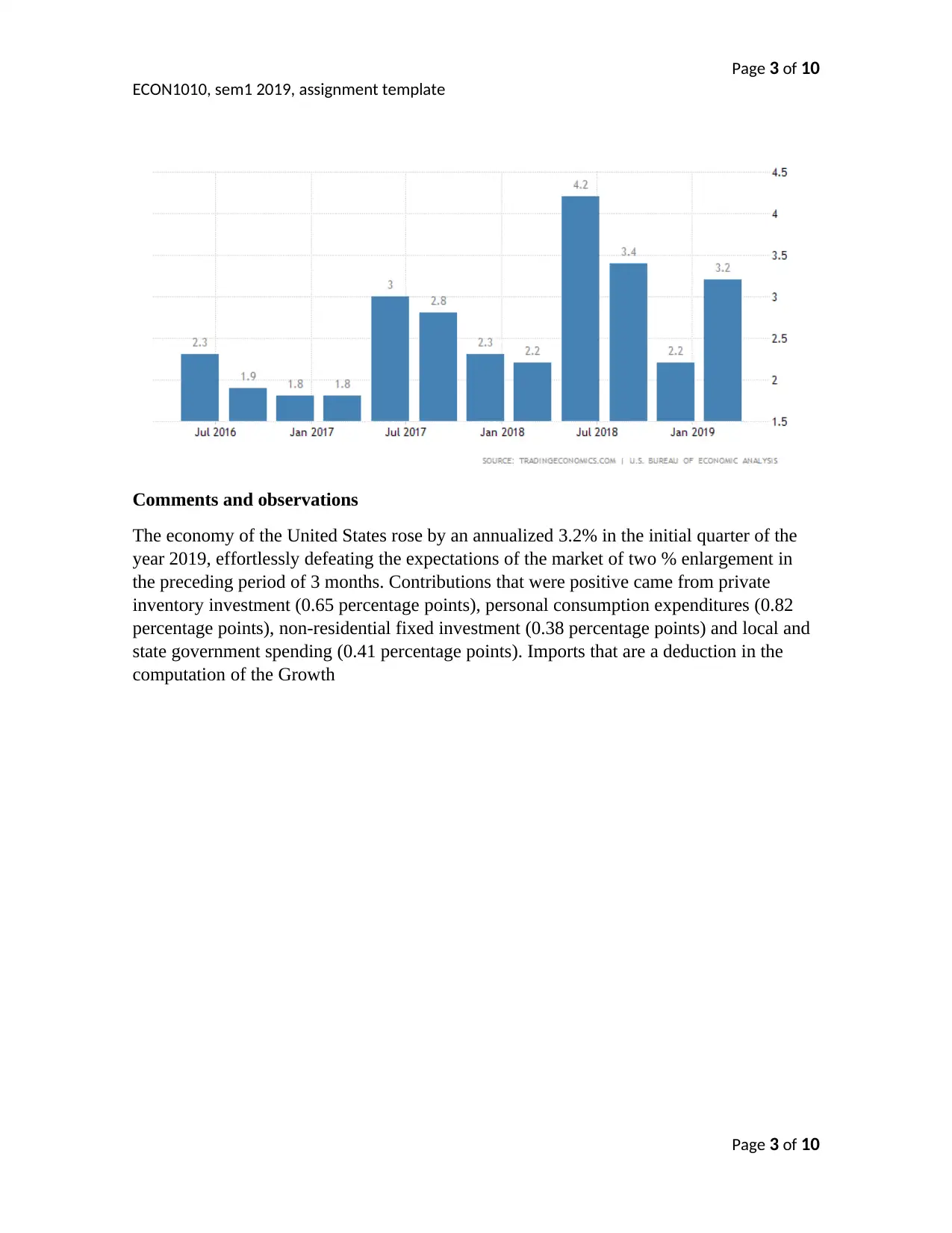
Page 3 of 10
ECON1010, sem1 2019, assignment template
Comments and observations
The economy of the United States rose by an annualized 3.2% in the initial quarter of the
year 2019, effortlessly defeating the expectations of the market of two % enlargement in
the preceding period of 3 months. Contributions that were positive came from private
inventory investment (0.65 percentage points), personal consumption expenditures (0.82
percentage points), non-residential fixed investment (0.38 percentage points) and local and
state government spending (0.41 percentage points). Imports that are a deduction in the
computation of the Growth
Page 3 of 10
ECON1010, sem1 2019, assignment template
Comments and observations
The economy of the United States rose by an annualized 3.2% in the initial quarter of the
year 2019, effortlessly defeating the expectations of the market of two % enlargement in
the preceding period of 3 months. Contributions that were positive came from private
inventory investment (0.65 percentage points), personal consumption expenditures (0.82
percentage points), non-residential fixed investment (0.38 percentage points) and local and
state government spending (0.41 percentage points). Imports that are a deduction in the
computation of the Growth
Page 3 of 10
⊘ This is a preview!⊘
Do you want full access?
Subscribe today to unlock all pages.

Trusted by 1+ million students worldwide
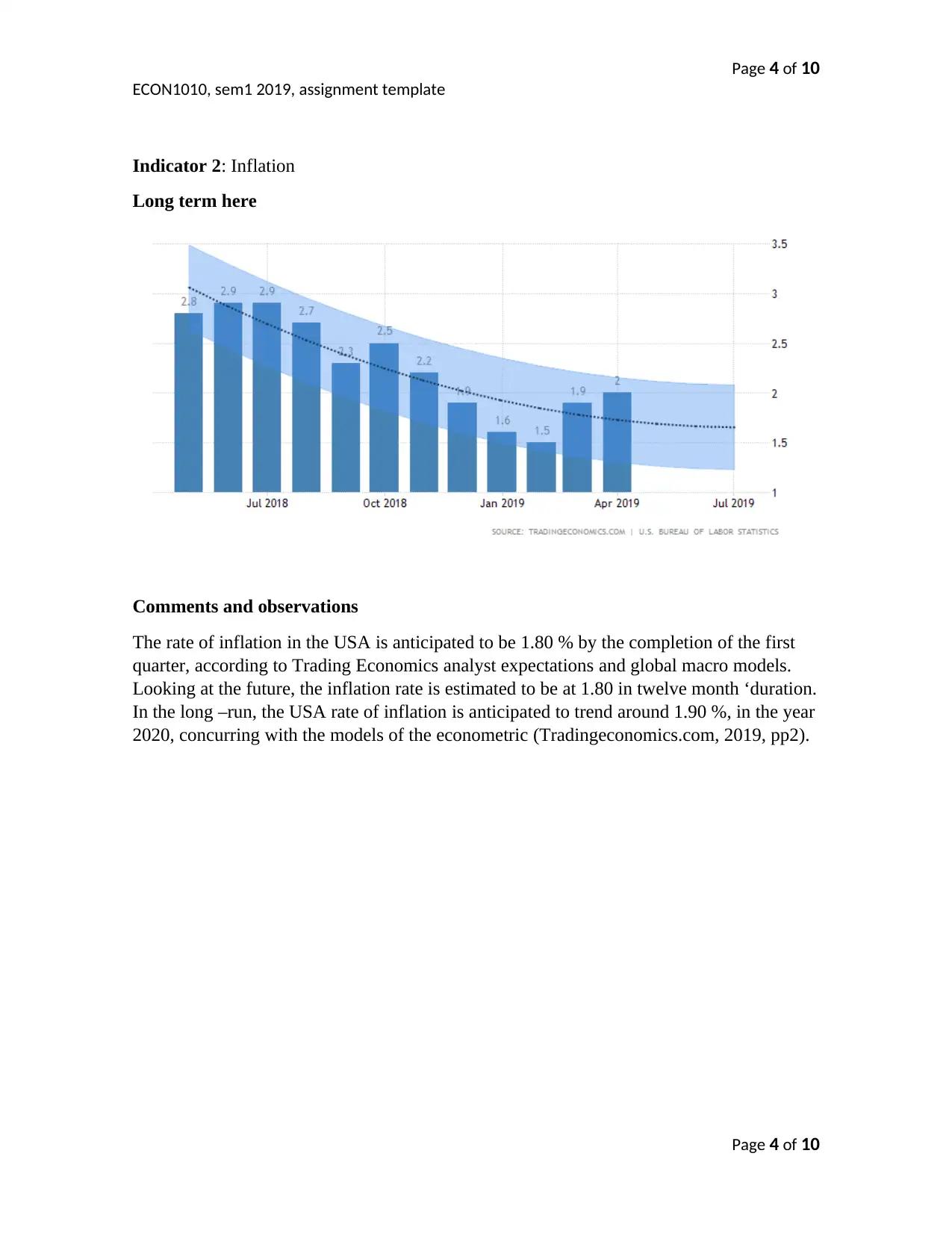
Page 4 of 10
ECON1010, sem1 2019, assignment template
Indicator 2: Inflation
Long term here
Comments and observations
The rate of inflation in the USA is anticipated to be 1.80 % by the completion of the first
quarter, according to Trading Economics analyst expectations and global macro models.
Looking at the future, the inflation rate is estimated to be at 1.80 in twelve month ‘duration.
In the long –run, the USA rate of inflation is anticipated to trend around 1.90 %, in the year
2020, concurring with the models of the econometric (Tradingeconomics.com, 2019, pp2).
Page 4 of 10
ECON1010, sem1 2019, assignment template
Indicator 2: Inflation
Long term here
Comments and observations
The rate of inflation in the USA is anticipated to be 1.80 % by the completion of the first
quarter, according to Trading Economics analyst expectations and global macro models.
Looking at the future, the inflation rate is estimated to be at 1.80 in twelve month ‘duration.
In the long –run, the USA rate of inflation is anticipated to trend around 1.90 %, in the year
2020, concurring with the models of the econometric (Tradingeconomics.com, 2019, pp2).
Page 4 of 10
Paraphrase This Document
Need a fresh take? Get an instant paraphrase of this document with our AI Paraphraser
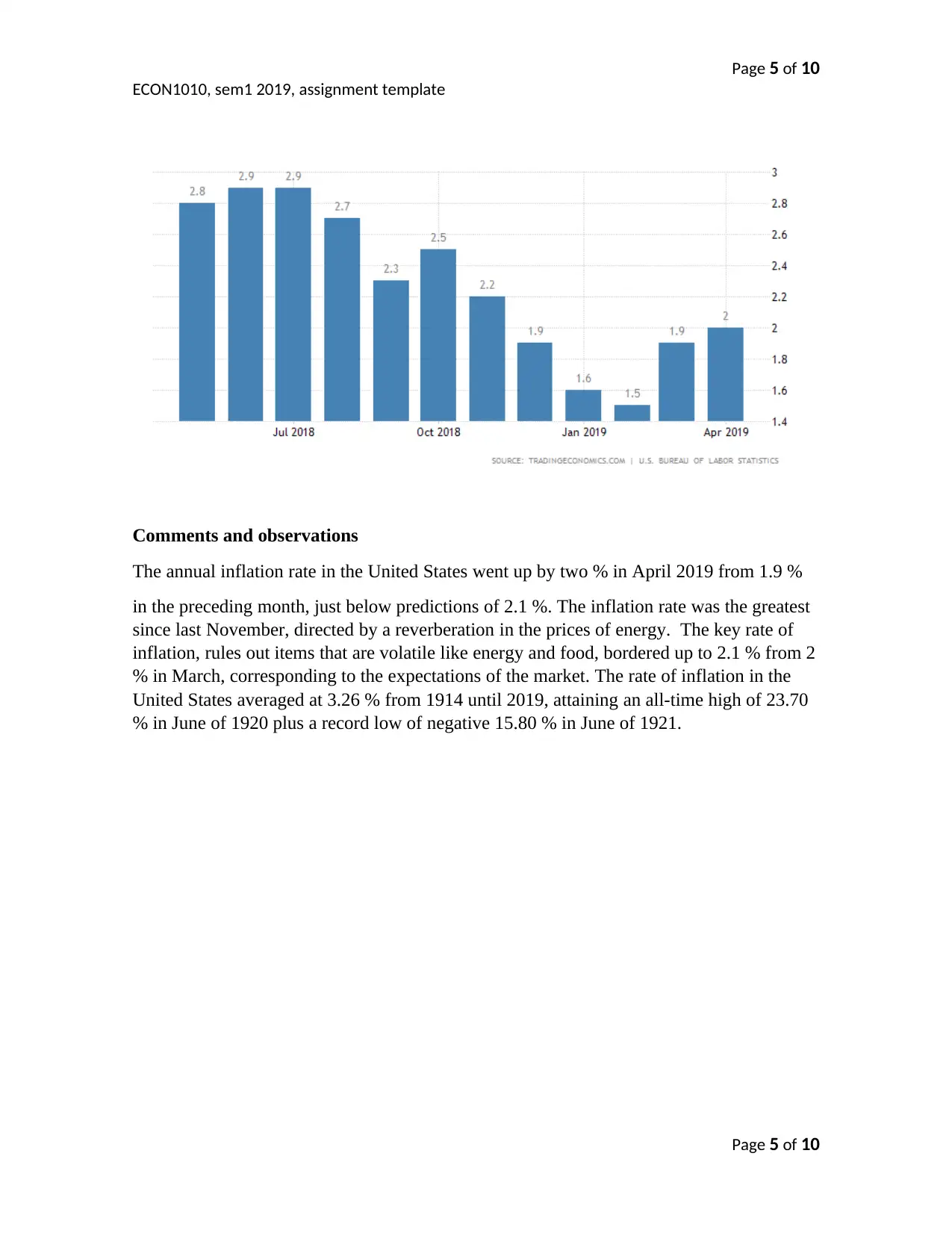
Page 5 of 10
ECON1010, sem1 2019, assignment template
Comments and observations
The annual inflation rate in the United States went up by two % in April 2019 from 1.9 %
in the preceding month, just below predictions of 2.1 %. The inflation rate was the greatest
since last November, directed by a reverberation in the prices of energy. The key rate of
inflation, rules out items that are volatile like energy and food, bordered up to 2.1 % from 2
% in March, corresponding to the expectations of the market. The rate of inflation in the
United States averaged at 3.26 % from 1914 until 2019, attaining an all-time high of 23.70
% in June of 1920 plus a record low of negative 15.80 % in June of 1921.
Page 5 of 10
ECON1010, sem1 2019, assignment template
Comments and observations
The annual inflation rate in the United States went up by two % in April 2019 from 1.9 %
in the preceding month, just below predictions of 2.1 %. The inflation rate was the greatest
since last November, directed by a reverberation in the prices of energy. The key rate of
inflation, rules out items that are volatile like energy and food, bordered up to 2.1 % from 2
% in March, corresponding to the expectations of the market. The rate of inflation in the
United States averaged at 3.26 % from 1914 until 2019, attaining an all-time high of 23.70
% in June of 1920 plus a record low of negative 15.80 % in June of 1921.
Page 5 of 10
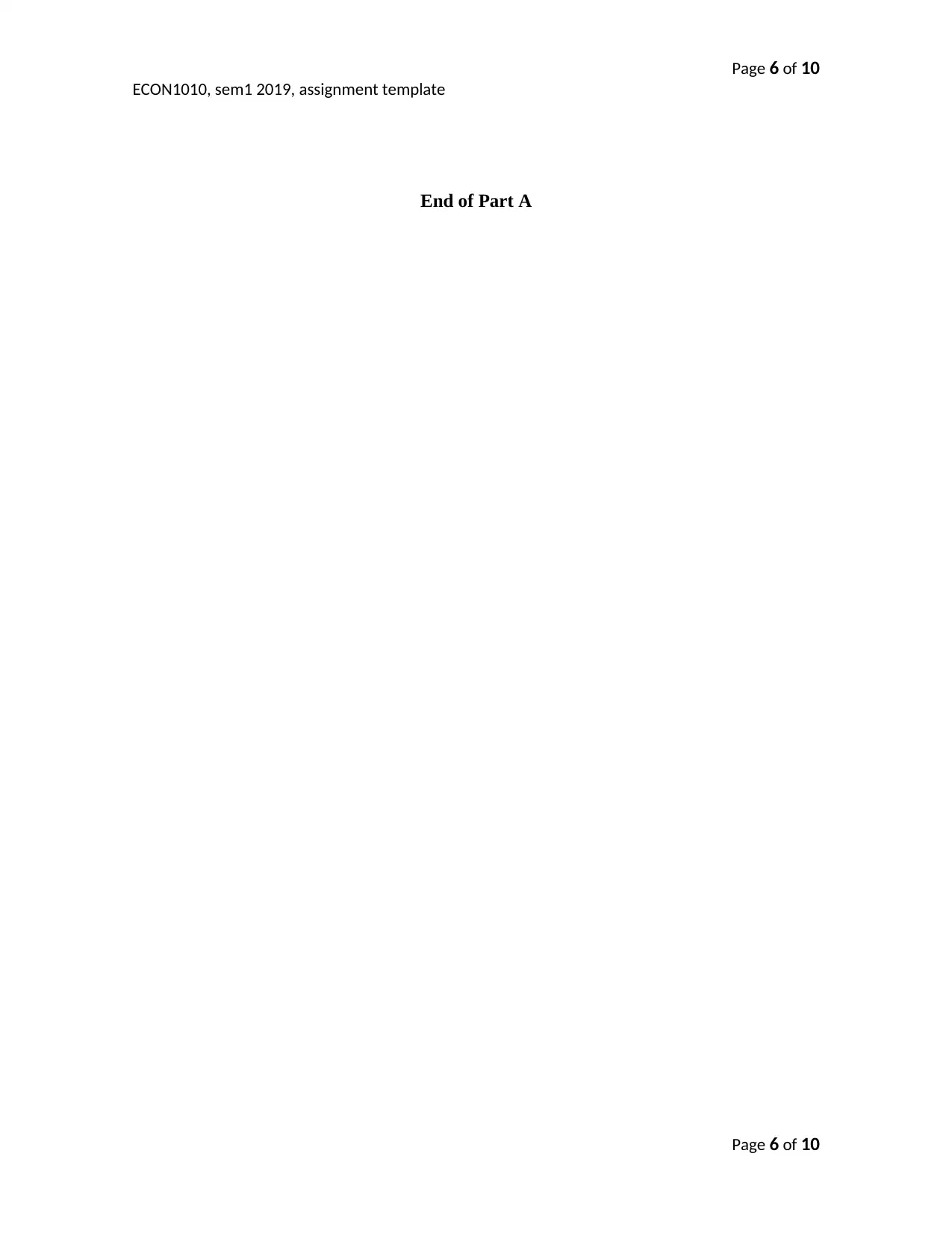
Page 6 of 10
ECON1010, sem1 2019, assignment template
End of Part A
Page 6 of 10
ECON1010, sem1 2019, assignment template
End of Part A
Page 6 of 10
⊘ This is a preview!⊘
Do you want full access?
Subscribe today to unlock all pages.

Trusted by 1+ million students worldwide
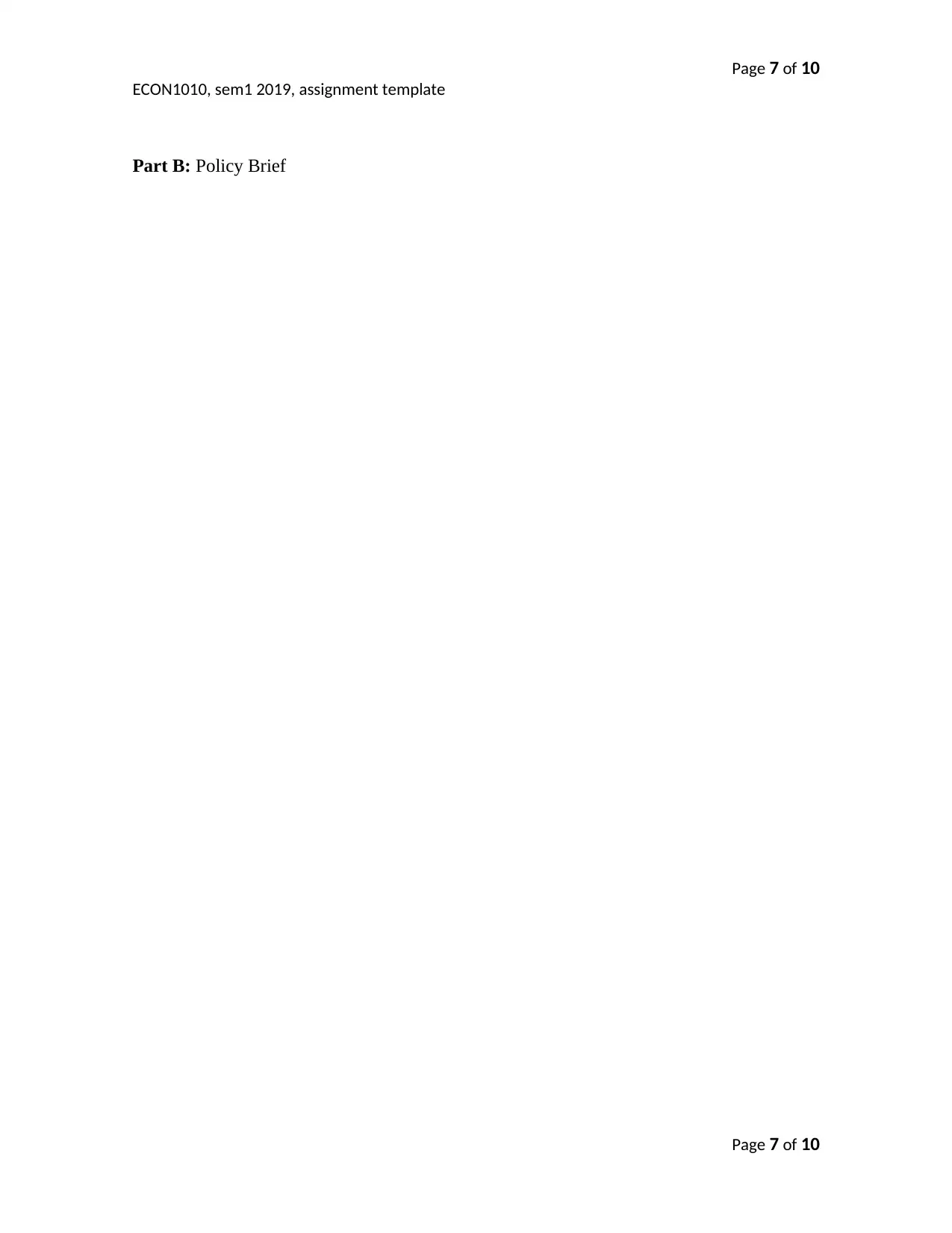
Page 7 of 10
ECON1010, sem1 2019, assignment template
Part B: Policy Brief
Page 7 of 10
ECON1010, sem1 2019, assignment template
Part B: Policy Brief
Page 7 of 10
Paraphrase This Document
Need a fresh take? Get an instant paraphrase of this document with our AI Paraphraser
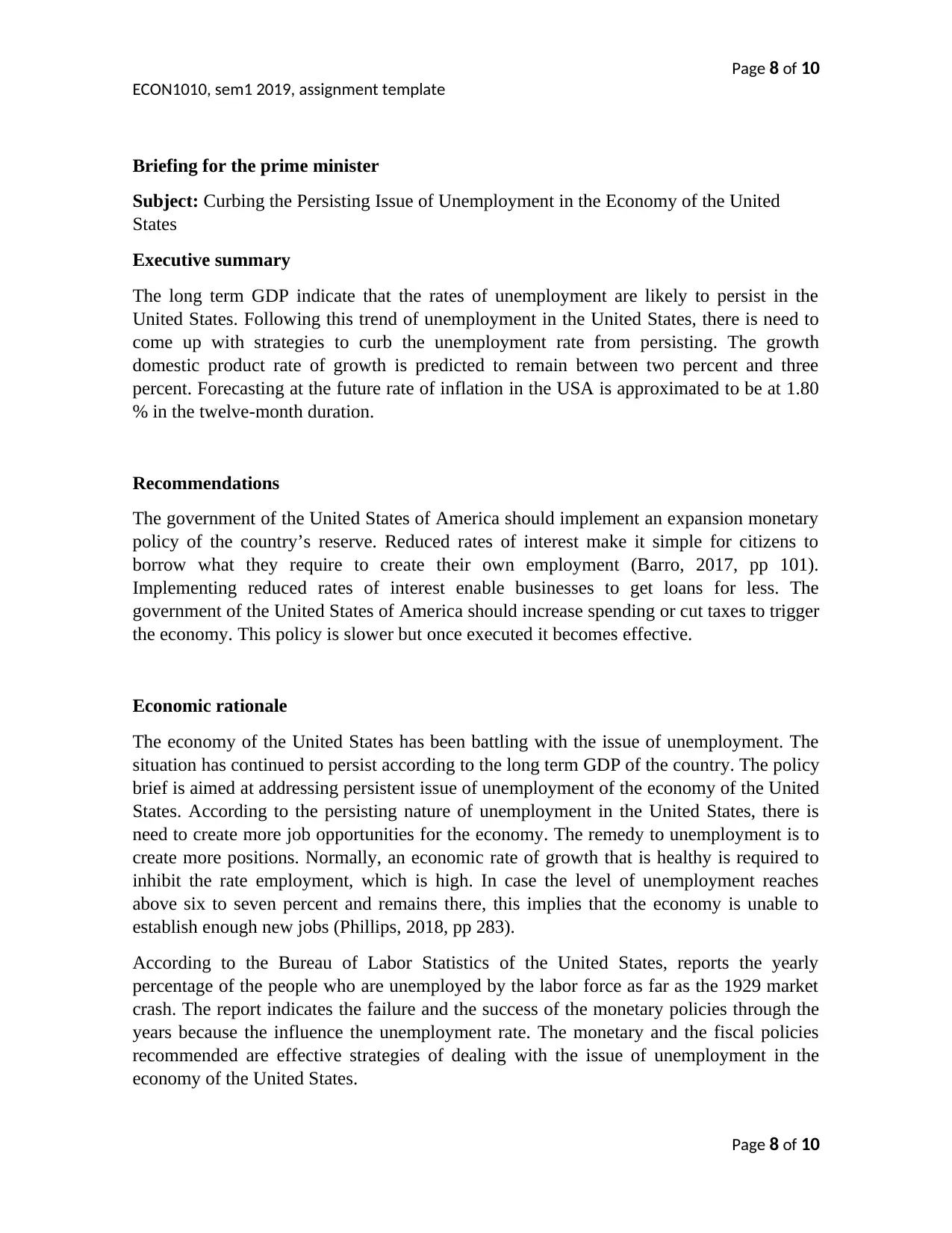
Page 8 of 10
ECON1010, sem1 2019, assignment template
Briefing for the prime minister
Subject: Curbing the Persisting Issue of Unemployment in the Economy of the United
States
Executive summary
The long term GDP indicate that the rates of unemployment are likely to persist in the
United States. Following this trend of unemployment in the United States, there is need to
come up with strategies to curb the unemployment rate from persisting. The growth
domestic product rate of growth is predicted to remain between two percent and three
percent. Forecasting at the future rate of inflation in the USA is approximated to be at 1.80
% in the twelve-month duration.
Recommendations
The government of the United States of America should implement an expansion monetary
policy of the country’s reserve. Reduced rates of interest make it simple for citizens to
borrow what they require to create their own employment (Barro, 2017, pp 101).
Implementing reduced rates of interest enable businesses to get loans for less. The
government of the United States of America should increase spending or cut taxes to trigger
the economy. This policy is slower but once executed it becomes effective.
Economic rationale
The economy of the United States has been battling with the issue of unemployment. The
situation has continued to persist according to the long term GDP of the country. The policy
brief is aimed at addressing persistent issue of unemployment of the economy of the United
States. According to the persisting nature of unemployment in the United States, there is
need to create more job opportunities for the economy. The remedy to unemployment is to
create more positions. Normally, an economic rate of growth that is healthy is required to
inhibit the rate employment, which is high. In case the level of unemployment reaches
above six to seven percent and remains there, this implies that the economy is unable to
establish enough new jobs (Phillips, 2018, pp 283).
According to the Bureau of Labor Statistics of the United States, reports the yearly
percentage of the people who are unemployed by the labor force as far as the 1929 market
crash. The report indicates the failure and the success of the monetary policies through the
years because the influence the unemployment rate. The monetary and the fiscal policies
recommended are effective strategies of dealing with the issue of unemployment in the
economy of the United States.
Page 8 of 10
ECON1010, sem1 2019, assignment template
Briefing for the prime minister
Subject: Curbing the Persisting Issue of Unemployment in the Economy of the United
States
Executive summary
The long term GDP indicate that the rates of unemployment are likely to persist in the
United States. Following this trend of unemployment in the United States, there is need to
come up with strategies to curb the unemployment rate from persisting. The growth
domestic product rate of growth is predicted to remain between two percent and three
percent. Forecasting at the future rate of inflation in the USA is approximated to be at 1.80
% in the twelve-month duration.
Recommendations
The government of the United States of America should implement an expansion monetary
policy of the country’s reserve. Reduced rates of interest make it simple for citizens to
borrow what they require to create their own employment (Barro, 2017, pp 101).
Implementing reduced rates of interest enable businesses to get loans for less. The
government of the United States of America should increase spending or cut taxes to trigger
the economy. This policy is slower but once executed it becomes effective.
Economic rationale
The economy of the United States has been battling with the issue of unemployment. The
situation has continued to persist according to the long term GDP of the country. The policy
brief is aimed at addressing persistent issue of unemployment of the economy of the United
States. According to the persisting nature of unemployment in the United States, there is
need to create more job opportunities for the economy. The remedy to unemployment is to
create more positions. Normally, an economic rate of growth that is healthy is required to
inhibit the rate employment, which is high. In case the level of unemployment reaches
above six to seven percent and remains there, this implies that the economy is unable to
establish enough new jobs (Phillips, 2018, pp 283).
According to the Bureau of Labor Statistics of the United States, reports the yearly
percentage of the people who are unemployed by the labor force as far as the 1929 market
crash. The report indicates the failure and the success of the monetary policies through the
years because the influence the unemployment rate. The monetary and the fiscal policies
recommended are effective strategies of dealing with the issue of unemployment in the
economy of the United States.
Page 8 of 10

Page 9 of 10
ECON1010, sem1 2019, assignment template
Fiscal policy
The rate of inflation in the USA is anticipated to be 1.80 % by the completion of the first
quarter, according to Trading Economics analyst expectations and global macro models.
The fiscal policy can be more efficient once implemented. Moreover, it offers the much
required confidence that government will turn things around (Cantor and Land, 2015, pp
317). Unemployment can be decreased by the fiscal policy by assisting to elevate the
economic growth rate and the cumulative demand. The government will require to follow
the expansionary fiscal policy, this entails increasing government spending and cutting
taxes. Reduced taxes escalate the income that is disposable for instance VAT cut fifteen
percent in the year 2008 and thus assist in intensifying consumption, resulting to higher
aggregate demand. An intensification of the aggregate demand results in an increase in the
Real Growth Domestic Product for as long as there exists a spare capacity in the economy.
In case organizations in the United States can produce more, there will be an escalation in
demand for employees and thus decrease unemployment that is demand-deficient.
Moreover, with strong economic growth and higher aggregate demand, few organizations
will run bankrupt implying fewer losses of jobs
Monetary policy
The USA rate of inflation is anticipated to trend around 1.90 %, in the year 2020, according
to the models of the econometric. The low rates of interest enables businesses to borrow for
less. That provides the financial capital to recruit adequate employees to meet the elevating
demand.
Monetary policy is often associated with macroeconomic performance standards that seem
seem desirable attractive, a stable price level, a low unemployment rate and economic
growth. Therefore, it is sensible to conclude that the objectives of the monitory policy is
supposed to in cooperate the avoidance of deflation or inflation, maintenance of full
employment and the maintenance of full employment. However, the objectives, each of
which is attractive by itself, can clash with each other. A monetary policy that pursues to
minimize inflation may weaken economic growth and increase unemployment. The
economy of the United States has been battling with the issue of unemployment. The
situation has continued to persist according to the long term GDP of the country. To
undertake a monetary policy that is expansionary, the government of America can purchase
bonds, thus maximizing the supply of money. According to the persisting nature of
unemployment in the United States, there is need to create more job opportunities for the
economy. The remedy to unemployment is to create more positions.
Besides, the government of USA can implement supply side policies for decreasing supply
side unemployment, which include training and education, minimizing the trade unions
power, fostering the flexibility of labor market, workers subsidies, severer benefit
requirements and improved geographical mobility. It is debated that greater unemployment
Page 9 of 10
ECON1010, sem1 2019, assignment template
Fiscal policy
The rate of inflation in the USA is anticipated to be 1.80 % by the completion of the first
quarter, according to Trading Economics analyst expectations and global macro models.
The fiscal policy can be more efficient once implemented. Moreover, it offers the much
required confidence that government will turn things around (Cantor and Land, 2015, pp
317). Unemployment can be decreased by the fiscal policy by assisting to elevate the
economic growth rate and the cumulative demand. The government will require to follow
the expansionary fiscal policy, this entails increasing government spending and cutting
taxes. Reduced taxes escalate the income that is disposable for instance VAT cut fifteen
percent in the year 2008 and thus assist in intensifying consumption, resulting to higher
aggregate demand. An intensification of the aggregate demand results in an increase in the
Real Growth Domestic Product for as long as there exists a spare capacity in the economy.
In case organizations in the United States can produce more, there will be an escalation in
demand for employees and thus decrease unemployment that is demand-deficient.
Moreover, with strong economic growth and higher aggregate demand, few organizations
will run bankrupt implying fewer losses of jobs
Monetary policy
The USA rate of inflation is anticipated to trend around 1.90 %, in the year 2020, according
to the models of the econometric. The low rates of interest enables businesses to borrow for
less. That provides the financial capital to recruit adequate employees to meet the elevating
demand.
Monetary policy is often associated with macroeconomic performance standards that seem
seem desirable attractive, a stable price level, a low unemployment rate and economic
growth. Therefore, it is sensible to conclude that the objectives of the monitory policy is
supposed to in cooperate the avoidance of deflation or inflation, maintenance of full
employment and the maintenance of full employment. However, the objectives, each of
which is attractive by itself, can clash with each other. A monetary policy that pursues to
minimize inflation may weaken economic growth and increase unemployment. The
economy of the United States has been battling with the issue of unemployment. The
situation has continued to persist according to the long term GDP of the country. To
undertake a monetary policy that is expansionary, the government of America can purchase
bonds, thus maximizing the supply of money. According to the persisting nature of
unemployment in the United States, there is need to create more job opportunities for the
economy. The remedy to unemployment is to create more positions.
Besides, the government of USA can implement supply side policies for decreasing supply
side unemployment, which include training and education, minimizing the trade unions
power, fostering the flexibility of labor market, workers subsidies, severer benefit
requirements and improved geographical mobility. It is debated that greater unemployment
Page 9 of 10
⊘ This is a preview!⊘
Do you want full access?
Subscribe today to unlock all pages.

Trusted by 1+ million students worldwide
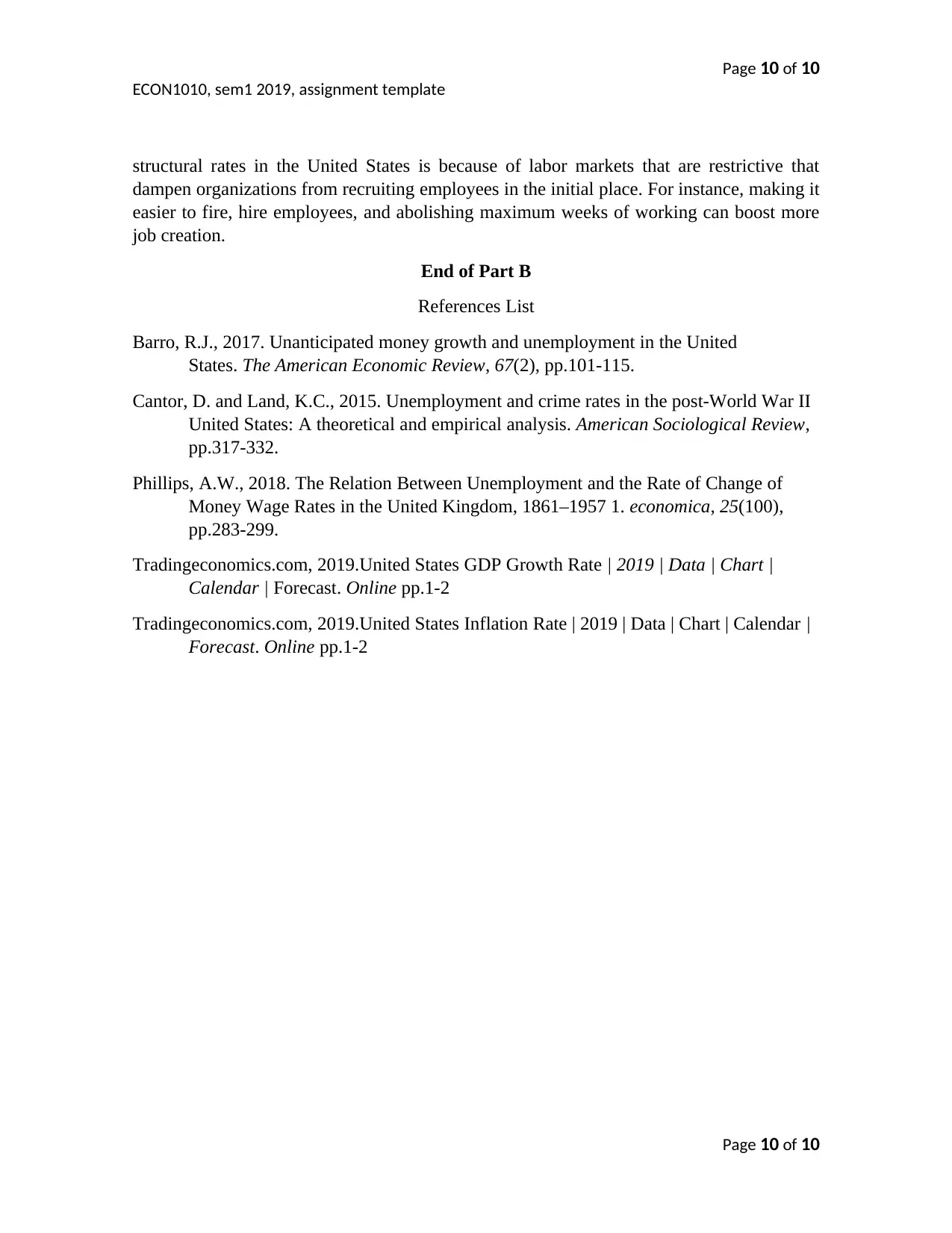
Page 10 of 10
ECON1010, sem1 2019, assignment template
structural rates in the United States is because of labor markets that are restrictive that
dampen organizations from recruiting employees in the initial place. For instance, making it
easier to fire, hire employees, and abolishing maximum weeks of working can boost more
job creation.
End of Part B
References List
Barro, R.J., 2017. Unanticipated money growth and unemployment in the United
States. The American Economic Review, 67(2), pp.101-115.
Cantor, D. and Land, K.C., 2015. Unemployment and crime rates in the post-World War II
United States: A theoretical and empirical analysis. American Sociological Review,
pp.317-332.
Phillips, A.W., 2018. The Relation Between Unemployment and the Rate of Change of
Money Wage Rates in the United Kingdom, 1861–1957 1. economica, 25(100),
pp.283-299.
Tradingeconomics.com, 2019.United States GDP Growth Rate | 2019 | Data | Chart |
Calendar | Forecast. Online pp.1-2
Tradingeconomics.com, 2019.United States Inflation Rate | 2019 | Data | Chart | Calendar |
Forecast. Online pp.1-2
Page 10 of 10
ECON1010, sem1 2019, assignment template
structural rates in the United States is because of labor markets that are restrictive that
dampen organizations from recruiting employees in the initial place. For instance, making it
easier to fire, hire employees, and abolishing maximum weeks of working can boost more
job creation.
End of Part B
References List
Barro, R.J., 2017. Unanticipated money growth and unemployment in the United
States. The American Economic Review, 67(2), pp.101-115.
Cantor, D. and Land, K.C., 2015. Unemployment and crime rates in the post-World War II
United States: A theoretical and empirical analysis. American Sociological Review,
pp.317-332.
Phillips, A.W., 2018. The Relation Between Unemployment and the Rate of Change of
Money Wage Rates in the United Kingdom, 1861–1957 1. economica, 25(100),
pp.283-299.
Tradingeconomics.com, 2019.United States GDP Growth Rate | 2019 | Data | Chart |
Calendar | Forecast. Online pp.1-2
Tradingeconomics.com, 2019.United States Inflation Rate | 2019 | Data | Chart | Calendar |
Forecast. Online pp.1-2
Page 10 of 10
1 out of 10
Your All-in-One AI-Powered Toolkit for Academic Success.
+13062052269
info@desklib.com
Available 24*7 on WhatsApp / Email
![[object Object]](/_next/static/media/star-bottom.7253800d.svg)
Unlock your academic potential
Copyright © 2020–2025 A2Z Services. All Rights Reserved. Developed and managed by ZUCOL.

